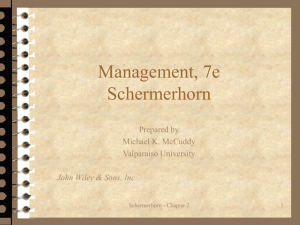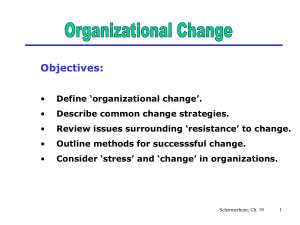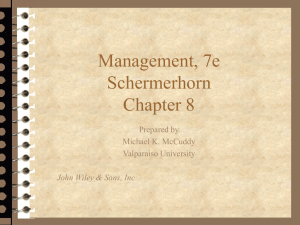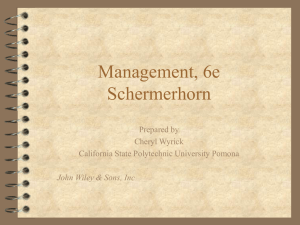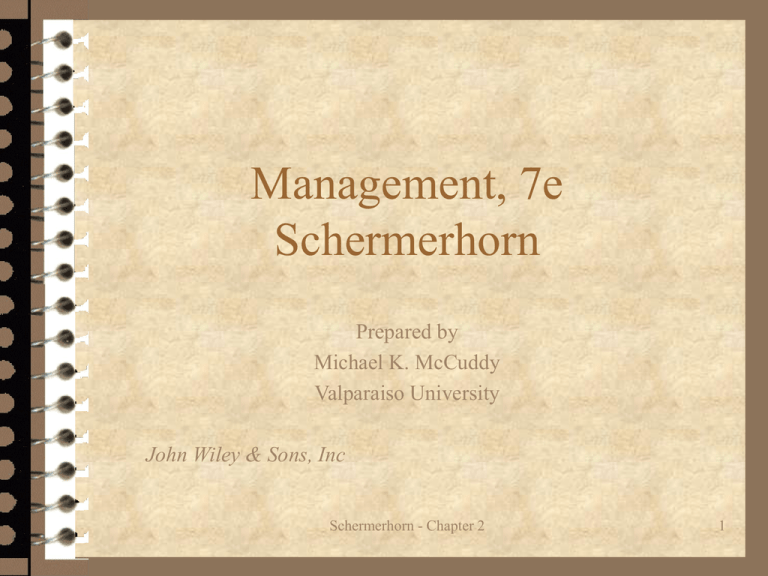
Management, 7e
Schermerhorn
Prepared by
Michael K. McCuddy
Valparaiso University
John Wiley & Sons, Inc
Schermerhorn - Chapter 2
1
COPYRIGHT
Copyright 2002 © John Wiley & Sons, Inc. All rights reserved.
Reproduction or translation of this work beyond that named in
Section 117 of the United States Copyright Act without the express
written permission of the copyright owner is unlawful. Requests for
further information should be addressed to the Permissions
Department, John Wiley & Sons, Inc. The purchaser may make backup copies for his/her own use only and not for distribution or resale.
The Publisher assumes no responsibility for errors, omissions, or
damages, caused by the use of these programs or from the use of the
information contained herein.
Schermerhorn - Chapter 2
2
Chapter 2
Environment and Diversity
Planning ahead—study questions
– What is the external environment of
organizations?
– What is a customer-driven organization?
– What is a quality-driven organization?
– What is the internal environment and
organizational culture?
– How is diversity managed in a multicultural
organization?
Schermerhorn - Chapter 2
3
What is the external environment of
organizations?
Competitive advantage involves utilization
of a core competency that clearly sets an
organization apart from competitors and
gives it an advantage over them in the
marketplace.
Schermerhorn - Chapter 2
4
What is the external environment of
organizations?
Companies may achieve competitive
advantage in many ways, including:
• Products
• Pricing
• Customer service
• Cost efficiency
• Quality
Schermerhorn - Chapter 2
5
What is the external environment of
organizations?
The general environment—all of the
background conditions in the external
environment of the organization including:
–
–
–
–
–
Economic
Social-cultural
Legal-political
Technological
Natural environment
Schermerhorn - Chapter 2
6
What is the external environment of
organizations?
The specific (task) environment—actual
organizations, groups, and persons with
whom an organization must interact in order
to survive and prosper.
Schermerhorn - Chapter 2
7
What is the external environment of
organizations?
Stakeholders in the specific environment
broadly include:
• Customers
• Suppliers
• Competitors
• Regulators
Schermerhorn - Chapter 2
8
What is the external environment of
organizations?
Environmental uncertainty is a lack of
complete information regarding what
developments will occur in the external
environment.
Two dimensions of environmental
uncertainty:
– Complexity
– Rate of change
Schermerhorn - Chapter 2
9
What is a customer-driven organization?
External customers purchase the
organization’s goods or utilize its services.
Internal customers are the persons and
groups within an organization who depend
on the results of others' work to do their
own jobs.
Schermerhorn - Chapter 2
10
What is a customer-driven organization?
Customer service lessons:
– Protect reputation for quality products.
– Treat customers right.
Assessing customer needs—what, where,
and when.
Adding value—high quality, low cost, and
on-time delivery.
Schermerhorn - Chapter 2
11
What is a customer-driven organization?
Customer relationship management
involves taking a strategic customercentered focus in building relationships and
adding value.
Supply chain management involves
strategic management of all operations
relating to suppliers of resources.
Schermerhorn - Chapter 2
12
What is a quality-driven organization?
International Standards Organizations (ISO)
certification
– Indicates that a company meets a rigorous set of
quality standards
ISO 9000
– Indicates that a company has met rigorous
quality standards in all operations
Schermerhorn - Chapter 2
13
What is a quality-driven organization?
Total quality management (TQM)
– Quality principles are an integral part of
organization's strategic objectives.
• Applying them to all aspects of operations
• Committing to continuous improvement
• Striving to meet customers’ needs correctly the first
time
Schermerhorn - Chapter 2
14
What is a quality-driven organization?
Crosby’s “four absolutes” of management
for total quality control:
– Quality means conformance to standards.
– Quality comes from defect prevention, not
defect correction.
– Quality as a performance standard must mean
defect-free work.
– Quality saves money.
Schermerhorn - Chapter 2
15
What is a quality-driven organization?
Quality and continuous improvement
– Deming’s basic proposition is that the cause of
quality problems may be:
• Some component of the production/operations
process.
• Internal to the production/operations system itself.
– Continuous improvement
• Always looking for new ways to improve upon
current performance.
Schermerhorn - Chapter 2
16
What is a quality-driven organization?
Quality circles
– A group of workers who meet regularly to
discuss ways of improving quality of their
products or services.
– Can result in cost savings from improved
quality and increased customer satisfaction.
Schermerhorn - Chapter 2
17
What is a quality-driven organization?
Quality and manufacturing technology:
– Lean production
• Uses new technologies to streamline systems
– Flexible manufacturing
• Processes can be changed quickly to produce
different products
– Agile manufacturing/mass customization
• Permits quick production of individualized products
Schermerhorn - Chapter 2
18
What is a quality-driven organization?
Quality and product design:
– A good design has eye appeal and is easy to
manufacture with productivity.
– A robust design can withstand manufacturing
fluctuations.
– Design for manufacturing emphasizes lower
production costs and high-quality products.
– Design for disassembly involves taking into
account how components will be recycled.
Schermerhorn - Chapter 2
19
What is the internal environment and
organizational culture?
Organizational culture is the system of
shared beliefs and values that develops
within an organization and guides the
behavior of its members.
Schermerhorn - Chapter 2
20
What is the internal environment and
organizational culture?
Strong cultures
– Commit members to do things that are in the best
interests of the organization.
– Reinforce these habits.
The best organizations have strong cultures that:
– Are performance-oriented
– Emphasize teamwork
– Allow for risk taking
– Encourage innovation
– Value the well being of people
Schermerhorn - Chapter 2
21
What is the internal environment and
organizational culture?
Levels of Organizational Culture
– Observable culture
• What one sees and hears when walking around an
organization.
– Core culture
• Core values that influence behavior and give rise to
observable culture.
Schermerhorn - Chapter 2
22
What is the internal environment and
organizational culture?
Leadership and organizational culture:
– Leaders should establish and maintain
appropriate core values.
– Criteria for evaluating core values:
• Relevance
• Pervasiveness
• Strength
– Symbolic leaders use symbols to establish and
maintain a desired culture.
Schermerhorn - Chapter 2
23
How is diversity managed in a
multicultural organization?
Characteristics of multicultural
organizations:
– Pluralism
– Structural integration
– Informal network integration
– Absence of prejudice and discrimination
– Minimum intergroup conflict
Schermerhorn - Chapter 2
24
How is diversity managed in a
multicultural organization?
Organizational subcultures
– Cultures based on shared work responsibilities and/or
personal characteristics.
Common subcultures include:
– Occupational
– Functional
– Ethnic
– Racial
– Generational
– Gender
Schermerhorn - Chapter 2
25
How is diversity managed in a
multicultural organization?
Diversity can be a source of competitive
advantage.
Diversity leadership approaches:
– Affirmative action
– Valuing diversity
– Managing diversity
Schermerhorn - Chapter 2
26
How is diversity managed in a
multicultural organization?
Personal challenge of managing diversity:
– Accepting the goal of diversity maturity
Organizational challenge of managing
diversity:
– Changing organizational culture
– Changing organizational mission and practices
Schermerhorn - Chapter 2
27


